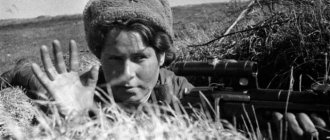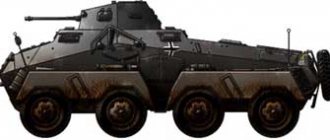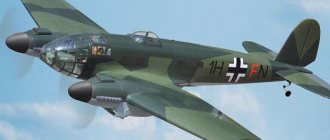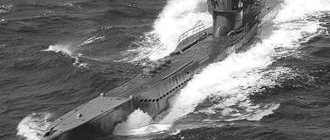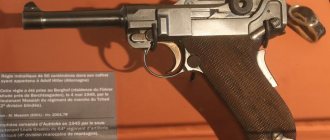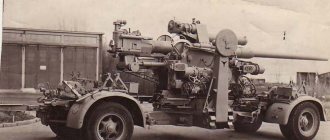History of creation
The history of the third Stug began in 1935, when the idea arose to create an “assault artillery” vehicle to support infantry. There is a possibility that this idea was accidentally suggested to the Germans by the Russians while discussing with the Daimler-Benz company the creation of a prototype self-propelled gun for the Red Army. The sketch was even developed, but the Soviet side was not satisfied with the price, and the deal did not take place.
In 1936, they ordered the design of an armored vehicle to support infantry. It should have been armed with a 75 mm cannon, and also fully armored to protect the crew. At the same time, the height of the vehicle should have been no higher than the height of the average soldier.
Daimler-Benz decided to use the chassis of the Pz tank for development. III, then it was still quite new, and the gun was installed from the first modifications of the Pz. IV. After collecting several prototypes in 1937, they were sent to practice tactical techniques. But development took a lot of time, so the Sturmgeschütz III did not have time to take part in the Polish campaign, and only entered production in February 1940. But then they were modified and produced throughout the Second World War.
StuG III ausf A, first modification
City Destroyers
During the Second World War, the most difficult combat mission was considered to be the storming of a fortified defensive area, saturated with long-term firing points ( pillboxes ), as well as large cities, where every multi-story building was turned into an impregnable fortress. To destroy such centers of resistance, extremely powerful combat vehicles were required. They were supposed to use high-explosive and concrete-piercing shells to break through gaps in the enemy’s defenses. The Americans solved this problem with air strikes and fire from long-range guns and howitzers. They installed 105 mm howitzers on the chassis of the M-24 Cheffi , and heavy 155 mm, 203 mm and even 240 mm howitzers on the chassis of the M-3 and M-4 tanks. These self-propelled guns did not have continuous armor, as they were intended for firing from long distances.
The 203-mm M-43 self-propelled howitzer fired shells weighing 90 kg at a range of up to 17 km. There was no need to fear return fire
Faced with fierce resistance from the Red Army in 1941, the Germans realized that without heavy-duty tanks it would be difficult to capture cities. In the fall of 1942, during the difficult Battle of Stalingrad, the idea of creating such a weapon became especially relevant. And at the end of 1942, in Germany, on the basis of the T-IV medium tank, they designed the self-propelled gun “Brummber” (“grizzly bear”) with a powerful 150-mm cannon. Because of the very thick armor, the Germans called this self-propelled gun an assault tank. However, the “bears” did not have to storm Soviet cities.
"Brummber"
When they appeared, the Red Army was already advancing. The clumsy "Brummber" with a short-barreled cannon was not suitable for battles in open areas. The exotic assault tank "Sturmtiger" was created in 1943 on the chassis of the T-VI "Tiger" heavy tank. The designers decided to use a rocket launcher that fires rockets weighing almost 350 kg! A projectile 1.5 m long and 38 cm in diameter, equipped with a jet engine, could fly 5.5 km and destroy a multi-storey building: 130 kg of explosives pierced a reinforced concrete wall 2.5 m thick. She created a weapon of terrible destructive power to arm ships. It was a rocket launcher. German tank crews called it a mortar. Therefore, the “rocket” tank began to be called “Sturmmortir”, but the name “Sturmtiger” stuck. In August 1944, the experienced Sturmtiger fought in Warsaw together with the Brummbers. The monstrous weapon destroyed everything around, turning houses into ruins.
"Sturmtiger"
The experienced Sturmtiger did not have the necessary reservations. Its cabin was welded from thick sheets of ordinary iron. The first production tank with 150 mm armor left the plant’s workshops only in September 1944. In total, 18 such supertanks were made...
TTX
general information
- Classification – assault weapon;
- Combat weight - 23.4 tons;
- Layout diagram - transmission compartment in front, engine compartment in the rear, controls and combat compartment in the center;
- Crew – 4 people;
- Years of development: 1937;
- Years of production – 1940-1945;
- Years of operation – 1940-1950;
- A total of 10,500 vehicles were produced.
Dimensions
- Hull length - 6770 mm, the same with the gun forward;
- Hull width – 2950 m;
- Height – 2950 mm;
- Ground clearance – 385 mm.
Booking
- Type of armor – cast and rolled steel;
- Body forehead, top - 25+30 / 85° mm/degree;
- Body side – 30 mm;
- Hull stern, top - 30 / 30° mm/degree;
- Bottom – 19 mm;
- Hull roof - 16/78-87° mm/degree;
- Cutting forehead - 50+30 / 9° mm/degree;
- Gun mask - 50+30 / 5° mm/degree;
- Cabin side - 30 / 0° + 8 / 30° mm/degree;
- Cabin roof - 10/78-90° mm/degree.
Armament
- Gun - Stuk 40 L/48 caliber 75 mm;
- Gun type - rifled;
- Barrel length - 24 caliber;
- Gun ammunition - 54 rounds;
- BH angles - −10...+20° degrees;
- GN angles – 12 degrees;
- Sights - Periscopic sights SfI ZF 1a and RbIF 36;
- Machine gun - MG 34 caliber 7.92 mm.
Mobility
- Engine type - V-shaped 12-cylinder carburetor, liquid-cooled;
- Engine power – 300 horsepower;
- Speed on highways and rough terrain – 38 km/h;
- Cruising range – 155 km;
- Specific power – 12.8 hp/t;
- Suspension type: Individual torsion bar, with hydraulic shock absorbers;
- Climbability – 30 degrees;
- The wall to be overcome is 0.6 m;
- The ditch to be overcome is 2.3 m;
- Fordability - 0.8 m.
Assault guns
During wars, not everything obeys classical rules. So the Sturmgeschutz became an exception to the rule. Having started the war as an infantry assault artillery gun, which had nothing at all to do with the tank forces of Germany (the crew members of the Sturmgeschutz were considered not tank crews, but artillerymen), this combat vehicle was adopted by the tank forces in the middle of the war. Moreover, if at the beginning of the war the crews of the light Sturmgeschutz were ordered not to engage in fights with enemy tanks, then at the end of the war they formed the basis of the Wehrmacht’s anti-tank units. At the same time, like other classic tanks, the latest series of Sturmgeschutz were equipped with both powerful guns and thick armor. These self-propelled guns also received machine gun armament. It was no longer just an artillery installation, merely supporting troops with fire from afar, but a real fighting machine, designed to conduct brutal close combat. In other words, a real tank, albeit a crazy one.
The Sturmgeschutz III assault gun of the initial period of the war had a short-barreled gun with a caliber of 75 mm
The development of armored vehicles during the war was subject to a single law of the development of life: the survival of the fittest. Not all combat vehicles created on the eve or even during the war were able to “survive” until its end. A typical example is the German heavy tank "Tiger", the production of which was discontinued in 1944. But the "Sturmgeschutz", on the contrary, were not only produced until the very end of the war, but their production was constantly increasing. It was the Sturmgeschutz that became the most popular armored vehicles in Germany. More than 10 thousand of them were produced. to produce turretless combat vehicles using simplified technology than “normal” tanks. And it yielded results. The Sturmgeschutz may not have been as good as the T-IV. But two Sturmgeschutz on the battlefield were still more effective than one Panzer.
Self-propelled guns "Sturmgeschutz" were produced on the basis of tanks T-III and T-IV, and therefore were called "Sturmgeschutz" III and "Sturmgeschutz" IV. At the end of the war they became the most sought after German weapon.
Over four years of continuous fighting, the Sturmgeschutz have changed. Maneuverable, equipped with a new long-barreled cannon and machine guns, and with sufficient armor, they turned out to be almost the main means of deterring the advancing enemy. Their only serious drawback (a non-rotating gun) in defensive battles was no longer so obvious. After all, self-propelled guns sitting in ambush do not need to turn the gun to fire in all directions, which is typical for tanks going on the offensive.
The low silhouette of the Sturmgeschutz IV self-propelled gun made this combat vehicle inconspicuous on the ground
Modifications
The StuG III was used extensively throughout the war and was regularly modified to keep it relevant.
- Ausf.A is the first production vehicle based on the Pz.Kpfw.III Ausf.F chassis. 36 were created, 6 were converted from Pz.Kpfw.III Ausf.G. They were used in May-June 1940, later sent to training units;
- Ausf.B - similar to the previous model, but with wide track tracks and road wheels, with a manual transmission. 300 were built and used until the end of 1942;
- Ausf.C - with new bow armor, without a gunner's sight and with an updated design of the driver's hatch for extending the sight behind a closed one. 50 machines created;
- Ausf.D - similar to the previous version, but had an internal intercom. 150 vehicles were built, some converted into command vehicles;
- Ausf.E - an updated version, with additional armor. 284 vehicles were built, some converted into command vehicles, with the addition of stroboscopic instruments;
- Ausf.F (Sd.Kfz 142/1) - had even more reinforced armor and a different gun - 7.5 cm StuK 40 L/43. Due to this, it fought much more effectively against British and Soviet tanks. In 1942, 366 vehicles were created;
- Ausf.F/8 – a vehicle with the hull of the Pz.Kpfw.III Ausf.J tank and attached armor plates. 250 built;
- Ausf.G - the latest version of the Stug from MIAG and Alkett, was produced from 1942 to 1945. A total of 7,720 units were built. 142 were assembled on the Pz.Kpfw.III Ausf. chassis, another 173 were converted from Pz.Kpfw.III. The hull was the same as the previous model, but the armor was improved, the commander was given a turret with a periscope;
- StuH 42 - self-propelled gun with a 105 mm howitzer;
- StuG (Fl) is a self-propelled flamethrower created in 1943. Not many vehicles were assembled; according to documents, they were not used in battle, and in 1944 they were converted into the StuG III Ausf.G.
StuG III Ausf.G
Fire support
Self-propelled artillery units , following tanks or in the ranks of infantry, supported the advance of tankers and infantrymen with their fire or, conversely, sitting in ambush, fired direct fire at advancing enemy tanks. The main quality of a self-propelled gun (in our country it is usually called a “self-propelled artillery installation”) is the power and accuracy of artillery fire. Typically, a self-propelled gun had a more powerful gun than a tank of the same weight. Booking is not the most important thing for her. After all, a self-propelled gun should not rush straight into the enemy’s forward positions. Its task is to wipe out identified targets from the face of the earth, destroying them from long distances, while remaining inaccessible to enemy tank and anti-tank guns.
self-propelled guns were produced in all countries of the world . On some self-propelled guns, the gun stood openly, on others it was located in fully armored casemates (wheelhouses). Many self-propelled guns had rotating turrets and were no different in appearance from conventional tanks.
SU-76
The most common self-propelled gun in the Red Army was the SU-76 (self-propelled gun with a 76-mm cannon), created in 1943 on the basis of the T-70 light tank. Its gun was located in a semi-open wheelhouse at the rear of the hull. This light self-propelled gun, distinguished by high maneuverability and mobility, was an indispensable assistant to Soviet infantrymen. A record number of such combat vehicles were produced during the war years - almost 14 thousand. More powerful, fully armored, self-propelled units were produced on the basis of the T-34 tank. Depending on the caliber of the gun installed on them, they were called SU-85, SU-100, SU-122.
German self-propelled guns such as "Wespe" or "Hummel" were in many ways reminiscent of the Soviet SU-76. They were also semi-open, but were armed with more powerful 105- and 150-mm cannons, respectively. The Germans themselves called them self-propelled field artillery systems. In the American army, self-propelled guns became widespread, the guns of which were installed not only in the wheelhouse, but also in a rotating turret, open at the top. Outwardly, they resembled the Sherman tank, as they were made on its basis.
"Vespe"
Vehicles based on Stug III
- Munitionspanzer auf StuG 40 Ausf. G – ammunition transporter. It did not have a cannon; sometimes a crane was placed on the roof to make it easier to load and unload ammunition. Was not very widespread;
- In the Soviet Union, several dozen SU-76Is were made from captured Stugs, with a higher deckhouse and inclined armor plates. The vehicles were actively used in 1943-1944, although captured StuG IIIs often fought on the side of the Red Army without modifications.
SU-76I
Combat use
The StuG III first saw action in Holland and France in the spring and summer of 1940. Overall they performed well, but it became clear that in order to effectively support the infantry the number of Stug units would need to be increased.
Typically, the Stugs were made up of batteries - six vehicles each, among which were combat self-propelled guns and a command half-track armored vehicle Sd.Kfz.253, as well as an ammunition transporter Sd.Kfz.252.
By the end of autumn 1940, enough Stugs had been produced to create divisions. During this period they fought in Yugoslavia and Greece, and the Germans had only lost one Sturmgeschutz III before the Eastern Front campaign.
After 1941
In 1941, the situation changed seriously, and units with Stugs began to suffer losses, although their number in the army only increased due to active production. StuG III fought in Africa in 1942, and after the defeat at El Alamein they lost almost all of their self-propelled guns.
The StuG.III Ausf.F/8, specially prepared for desert conditions, was sent to Naples at the beginning of 1942, and then to Tunisia, where they actively fought, but eventually surrendered to the Allies.
Of course, the third Stuga actively participated in Operation Barbarossa, and in fairly large numbers. Then they constantly fought on the Eastern Front - they were mainly modification B vehicles. They were quite effective in storming fortified areas. Tanks and anti-tank guns of the Red Army had difficulty penetrating frontal armor, and the low silhouette made it difficult to hit. So by the end of 1941, the Wehrmacht had lost less than a hundred self-propelled guns on the Eastern Front. Around the same time, captured StuG IIIs began to be used by the Red Army.
StuG III Ausf E captured by the Soviet Army
The StuG III/40 played a very important role in the third assault on Sevastopol, after which the city fell. It was the Stug crews who broke through to the Panorama building and planted the flag of the Third Reich on it. True, losses in this battle were also heavy.
The Germans lost many Stugs during the Battle of Stalingrad. After this, the batteries began to be equipped with vehicles of various modifications, adding StuН 42 to effectively combat field fortifications.
455 StuG III/40 took part in the Battle of Kursk. Quite a lot of cars were lost, many of them beyond repair. At the same time, Soviet troops began to create the SU-76I from captured Stugs, but they soon stopped doing this in favor of their self-propelled guns due to the unstable flow of trophies and complex repairs.
In 1944-1945, the German military industry could no longer produce enough Stugs to make up for their losses - the factories were destroyed by Allied aircraft. So in the end, by the end of World War II, very few of these machines remained.
In general, the StuG III self-propelled gun, according to experts, turned out to be very successful. It effectively fought tanks from ambush thanks to its low silhouette, and its armor allowed it to destroy enemy tanks much earlier than the enemy could knock out the self-propelled gun itself.
After World War II, StuG III was actively used in the Middle East and some European countries. The last military action in which the Stugs participated was the Six Day War of 1967.
Destroyed StuG III
Self-propelled howitzers of the Second World War. Part 4. Rare German self-propelled guns
At the initial stage of World War II, German troops captured rich European trophies, including armored vehicles of the defeated countries.
The Germans used some of the tanks practically without alterations, and on the chassis of some of them they created armored vehicles for various purposes: from ammunition transporters to self-propelled howitzers, which were often produced in very limited series. This article will focus on self-propelled howitzers Sturmpanzer II (Bison II) (only 12 produced), G.Pz. Mk. VI (e) (18 built: 6 with 150 mm and 12 with 105 mm howitzers) and 10.5 cm leFH 18/3(Sf) B2(f) (only 16 produced). Sturmpanzer II (Bison II)
The somewhat unexpected, although quite logical, success of the combat use of improvised self-propelled guns Sturmpanzer I Bison, armed with a 150-mm howitzer sIG 33 and built on the basis of the Pz.Kpfw.I Ausf.B light tank, opened a “second wind” for tanks of obsolete types. Work on installing various artillery systems on tank chassis in Germany continued. Since 1940, attempts to install heavy 150-mm howitzers, so necessary to support infantry on the battlefield, have been made in Germany many times.
German designers worked with various chassis of both light and medium tanks: from Pz.Kpfw.I to Pz.Kpfw.IV. Even before the Sturmpanzer I Bison went into production, German designers had plans to create something more efficient, built on the chassis and components of the Pz.Kpfw.II tanks. In October 1940, the Alkett company assembled the first prototype based on the Panzer II Ausf B tank chassis, which, as it turned out, did not provide enough space to accommodate such a massive gun, and also could not sufficiently dampen the recoil of the gun when fired. At the same time, the 150-mm infantry howitzer sIG 33 was installed on the tank without a carriage and wheels.
On February 18, 1941, the decision was made to build the Sturmpanzer II (sometimes called the Bison II) on a modified Pz.Kpfw.II tank chassis. The layout was left the same, but the tank's hull was lengthened by 600 mm and widened by 330 mm. One additional support roller was added to the chassis, resulting in a total of six. Unlike many German self-propelled guns, the same model Sturmpanzer I Bison, which resembled a birdhouse on tracks, or the Wespe self-propelled gun, the new self-propelled howitzer did not have armor plates protecting the crew along the entire length of the superstructure. Due to the almost complete absence of an armored cabin, the height of the self-propelled guns was small.
The armament remained unchanged. The infantry 150 mm howitzer sIG 33 was used, which the Germans installed on no tank chassis. The gun was equipped with a standard Rblf36 telescopic sight, which provided double magnification. The carried ammunition consisted of 30 rounds, almost entirely high-explosive fragmentation, but cumulative ammunition could also be used to combat armored targets. The pack carried a 7.92 mm MG34 machine gun, designed for protection against enemy infantry.
The driver-mechanic of the self-propelled gun was located in a small armored cabin in front of the fighting compartment. Unlike the base tank, it had a hatch for boarding and disembarking from the combat vehicle. The power plant, chassis elements and transmission were borrowed from the production tank without fundamental changes. The engine remains the same. It was a 6-cylinder petrol Maybach HL62 TRM, developing 140 hp. at 2800 rpm. According to other data, serial self-propelled guns could use a Büssing-NAG L8V engine with a maximum power of 150 hp. also at 2800 rpm.
The fuel was placed in two tanks with a total capacity of 200 liters. To ensure better cooling, two large hatches were cut into the roof of the engine compartment. This was also done because the self-propelled guns were initially planned to be used in North Africa, where the Afrika Korps under the command of General Rommel had already been transferred. The transmission was inherited from the tank and included a manual gearbox (5 forward speeds and one reverse) of the ZF Aphon SSG46 type, main and side clutches, as well as band brakes.
After all the changes, the weight of the self-propelled gun increased to 11.2 tons, which was 2.3 tons more than the base version of the tank. However, this fact did not have a serious impact on the driving performance of the car. The Sturmpanzer II could still reach 40 km/h when driving on the highway. But the power reserve decreased slightly from 200 km (for the tank) to 180 km when driving on paved roads. The production of self-propelled guns was carried out by the Alkett company in December 1941 - January 1942; a total of 12 self-propelled howitzers were assembled during this period. From these the 707th and 708th companies of heavy infantry guns were formed, which were sent to the North African theater of operations. Here they were quite actively used in battles, taking part in the battle of El Alamein. The last Sturmpanzer II (Bison II) were captured by the Allies in May 1943 after the surrender of German forces in Tunisia.
Tactical and technical characteristics of Sturmpanzer II: Overall dimensions: length - 5410 mm, width - 2600 mm, height - 1900 mm, ground clearance - 340 mm. Combat weight - 11.2 tons. Powerplant - Büssing-NAG L8V liquid-cooled carburetor engine, 150 hp. Maximum speed is 40 km/h (on the highway), about 20 km/h (over rough terrain). Cruising range - 180 km. Armament: 150 mm sIG 33 infantry howitzer and one 7.92 mm MG34 machine gun in storage. Ammunition - 30 shots. Crew - 4 people.
10.5 cm leFH 18/3(Sf) B2(f)
After the capture of France, German troops received at their disposal a wide variety of captured tanks of various years of production, which were in different technical conditions. Among other things, the Germans received about 160 heavy French Char B1 bis tanks. Most of them were used by the Germans without any special modifications, about 60 tanks were converted into flamethrowers, and 16 became 105-mm self-propelled howitzers, full name 10.5-cm leichte Feldhaubitze 18/3 (Sf.) auf Geschützwagen B2 (f) 740 (f).
The decision to create self-propelled artillery units based on the chassis of captured French tanks was made in Germany in March 1941. They were planned to be used to support the Flammenwerfer Auf Pz.Kpfw.B2 flamethrower tanks being created on the same tank chassis. The task posed to the designers was quickly solved by installing a 105-mm leFH18 light field howitzer in the open wheelhouse. To do this, the tank's turret with a 47-mm gun, as well as a 75-mm howitzer in the hull, were dismantled. On the roof of the fighting compartment there was a fixed wheelhouse, in the front plate of which a new gun was mounted. The thickness of the deckhouse armor was 20 mm, there was no roof. Pointing angles in the vertical plane ranged from -4 to +20 degrees, in the horizontal plane 15 degrees to the left and right. The carried ammunition consisted of 42 rounds.
It is worth noting that the 105-mm light field howitzer leFH 18 formed the basis of the Wehrmacht field artillery throughout the Second World War, so its choice was not accidental. The howitzer was in service with light divisions of artillery regiments and was the basis of all German divisional artillery. According to official data, the Wehrmacht had up to 7076 howitzers of this type in service. Naturally, at different times, German designers considered various options for increasing the mobility of this artillery system by installing it on various tank chassis.
The first prototype of the new self-propelled gun with a wheelhouse made of non-armored steel was ready by June 1941. At the same time, by the time work began, there were quite a few fully serviceable chassis of French heavy tanks. According to the production plans of the Armament Directorate, in 1941, only 10 of these self-propelled howitzers were produced in two batches of 5 vehicles. In 1942, 6 more tanks were converted in this way. Thus, the Rheinmetall Borsig company, located in Düsseldorf, assembled only 16 self-propelled artillery units of this type.
The dimensions of the new self-propelled howitzer were very impressive (height almost 3 meters, length - 6.5 meters), its appearance could be called awkward. But if the size of the self-propelled gun was not such a serious drawback, then the heavy weight had a stronger effect. The combat weight of the vehicle was inherited from the heavy tank and was no less than 32.5 tons, which was quite a lot for the 307-horsepower engine that remained unchanged. Even when driving on a highway, the self-propelled gun did not reach a speed of more than 28 km/h, and its range was relatively small - 150 km.
All released self-propelled guns received a letter designation in alphabetical order - from A to P. All vehicles entered service with the 93rd Artillery Regiment of the 26th Tank Division. The regiment consisted of three batteries of 4 self-propelled howitzers each, and 4 more vehicles were above standard. During the operation of this military equipment, shortcomings were almost immediately identified, which included low maneuverability and overloaded chassis, which often led to breakdowns. As of May 31, 1943, 14 vehicles remained combat-ready in the regiment. At the same time, they were transferred to a training unit located in Le Havre, and were replaced by 12 Wespe self-propelled guns. However, later, as the situation at the front became more complicated, self-propelled guns were returned to service. They were assigned to the 90th Panzer Division, which operated in Sardinia.
Tactical and technical characteristics of the 10.5 cm leFH 18/3(Sf) B2(f): Overall dimensions: length - about 6.5 m, width - 2.4 m, height - about 3 m. Combat weight - 32.5 t. Powerplant - 6-cylinder Renault gasoline engine with a power of 307 hp. Maximum speed is up to 28 km/h (on the highway). Cruising range - 135-150 km. Armament: 105 mm light field howitzer leFH 18/3 and one 7.92 mm MG34 machine gun in storage. Ammunition - 42 rounds. Crew - 4 people.
G.Pz. Mk. VI(e)
Unlike numerous French armored vehicles, British tanks were never used or converted en masse by the Germans. The only exception to some extent was the light English tanks Mk VI. Apparently, for the reason that they formed the basis of the tank fleet of the British Expeditionary Force in France and were captured by the Germans in at least some significant quantities. On the chassis of these tanks, the Germans manufactured two types of self-propelled guns, armed with a 105-mm light field howitzer leFH 16 and a 150-mm heavy field howitzer 15 cm sFH 13.
In both cases, we were talking about the use of outdated artillery systems dating back to the First World War. A version of the self-propelled howitzer with the full designation 10.5cm leFh16 auf Fgst Geschutzwagen Mk.VI(e) was ready in the summer of 1940. Modifications to the vehicle were primarily related to the installation of a 105-mm howitzer on a special carriage on a tank chassis. An artillery gun with a 22-caliber barrel length and no muzzle brake received vertical guidance angles ranging from -8 to +41 degrees. The crew of the self-propelled gun included 5 people: a driver, a commander, a gunner and two loaders.
The howitzer was located in an armored cabin, open at the top and rear, which appeared in place of a tank turret at the rear of the combat vehicle. The thickness of the wheelhouse armor ranged from 12 to 20 mm; the wheelhouse armor plates were located at slight angles and provided protection from bullets and shrapnel. As an alternative, the installation of a 150-mm sFH 13 howitzer was also considered. However, a gun of such a large caliber was too powerful for the chassis of a light British tank, which led to problems when firing. However, several captured tanks (up to 6) were still armed with such a weapon.
In total, the Germans assembled 12 self-propelled guns armed with a 105 mm howitzer and 6 with a 150 mm howitzer. For their production, the best-preserved British tanks Mk.VIb and Mk.VIc were used, which were stored at collection points for captured equipment in France. Essentially, these were wedges with rotating turrets, weighing just over 5 tons. On the basis of these light British tanks, the Germans also created an ammunition transporter (12 vehicles) and a mobile observation post (4 vehicles). All self-propelled guns and related equipment entered service with the 227th artillery regiment, as well as the 1st battery of assault guns newly formed within this unit.
Most likely, the self-propelled guns and the regiment departed for the Eastern Front in October 1941. These self-propelled howitzers received their baptism of fire in the battles near Leningrad. Moreover, according to the Germans, they could even be used to fight Soviet tanks. Self-propelled guns on an English chassis fought in the USSR until the end of 1942, when the last vehicles of this type were lost in battle.
Tactical and technical characteristics of G.Pz. Mk. VI (e): Combat weight - 6.5 tons. Powerplant - 6-cylinder Meadows ESTE gasoline engine with 88 hp. Armament is a 105 mm leFH 16 field howitzer and one 7.92 mm MG34 machine gun. Crew - 5 people.
Sources of information: https://www.aviarmor.net/tww2/tanks/germany/15cm_sig33_pz2.htm https://www.aviarmor.net/tww2/tanks/gb/light_mk6.htm https://wiki.wargaming.net /ru/Tank:G93_GW_Mk_VIe/History https://wiki.wargaming.net/ru/Tank:F28_105_leFH18B2/History https://stalinhdtv.livejournal.com/21397.html Materials from open sources
Tank in culture
The Stug 3 can be found in several games dedicated to World War II and tanks, for example, Behind Enemy Lines, Company of Heroes 2 and, of course, World of Tanks and War Thunder.
The car is also widely represented in bench modeling - plastic prefabricated models are produced in China, Japan and Russia.
Model StuG III from Zvezda
Memory of a tank
Not many StuG IIIs have survived to this day. Running vehicles are in the Parola Tank Museum in Finland, as well as in the private collection of John Phillips. Non-functional tanks are exhibited in France, Finland, Sweden, and Bulgaria. They are also in Russia - in the Kubinka Tank Museum and in the Museum of the Great Patriotic War in Moscow. These are mainly cars of the Ausf, G modification.
StuG III Ausf.G in Kubinka
Photo and video
StuG III Ausf.B
StuG III Ausf. C
StuG III Ausf.D
StuG III Ausf.F (Sd.Kfz 142/1)
StuG III Ausf.F/8
StuG III Ausf.E
StuG III StuG (Fl), flame-resistant
StuH 42
StuG III cross-section More material on the topic
- M4 Sherman
- New deadly tank T90MS


